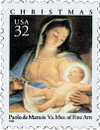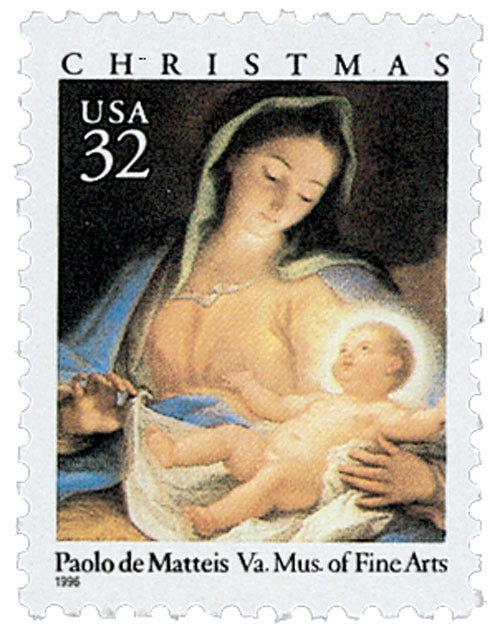
# 3112 - 1996 32c Traditional Christmas: Madonna and Child, booklet single
US #3112
1996 Christmas Madonna and Child
- Part of Traditional Christmas series
- First Madonna stamp issued as self-adhesive
- Features detail from 18th-century painting
- Marked 30th year of Traditional Christmas stamps
- Also produced with water-activated gum
Stamp Category: Commemorative, Special
Set: Traditional Christmas
Value: 32¢, First Class mail rate
First Day of Issue: November 1, 1996
First Day City: Richmond, Virginia
Quantity Issued: 847,750,000
Printed by: Bureau of Engraving and Printing
Printing Method: Lithographed and Engraved
Format: Booklet panes of 21 (20 stamps + 1 non-stamp label) from printing cylinders of 720
Perforations: Serpentine Die Cut 10
Why the stamp was issued: The stamp was issued for use on Christmas mail sent during the 1996 season. It is part of the Traditional Christmas series and the first self-adhesive stamp featuring the Madonna and Child.
About the stamp design: In 1995, Bureau of Engraving and Printing art director Richard Sheaff chose a list of possible Madonna and Child paintings for possible use on Traditional Christmas stamps. The detail from the Adoration of the Shepherds painting was chosen from that list to be the subject of the 1996 stamps. Sheaff used the middle of the painting from the stamp.
About the printing process: Most of the stamp design was produced using offset lithography. The line of small print at the bottom of the stamp design identifying the artist and location of the painting was the only part of the stamp that was engraved.
The non-stamp label has die cuts on it so it couldn’t be removed intact from the backing paper and used for postage.
First Day City: The First Day of Issue ceremony took place in the Great Hall of the Virginia Museum of Fine Arts in Richmond, Virginia. This museum houses the original painting from which the detail for the stamp came.
Unusual fact about this stamp: While most previous Madonna and Child paintings used for stamps were from the National Gallery of Art in Washington, DC, this one was housed in the Virginia Museum of Fine Arts.
About the Traditional Christmas Series: In 1966, the Post Office issued its first Madonna and Child stamp, a 15th century painting by Flemish painter Hans Memling. The stamp was very popular and over 1.1 billion were printed. This led the Post Office to issue another traditional Christmas stamp in 1968, this time picturing the Angel Gabriel. In 1969, they went back to more contemporary holiday subjects before finally deciding in 1970 to issue one Traditional Christmas stamp and one Contemporary Christmas stamp. Their decision proved popular and they’ve continued to issue both Traditional and Contemporary Christmas stamps ever since.
History the stamp represents: The 1996 Traditional Christmas stamp features a detail from Paolo de Matteis’s masterwork, Adoration of the Shepherds.
In 1712 de Matteis completed this oil painting for the Duchess of Laurenzano, a leading patron of the arts in Naples. Noted for the vibrant formal style typical of the late baroque period of Naples, it is considered a masterpiece by historians of Neapolitan art. In the original painting, Mary and baby Jesus are surrounded by Joseph, an angel, and others who came to gaze on the baby.
Paolo de Matteis studied under Luca Giordano, the dominant Neapolitan artist of the late 17th century. As was characteristic of late 17th- and 18th-century Italian artists, de Matteis made several trips to Rome, where he acquired knowledge of the works of earlier baroque artists such as Domenichino and Guido Reni. For three years, he also worked in Paris. The majority of de Matteis’s works however, were produced in Naples where many of them still reside.
In 1979, the Virginia Museum of Fine Arts acquired Adoration of the Shepherds. Measuring 791/2” x 70”, this jewel hangs in the museum’s great hall.
US #3112
1996 Christmas Madonna and Child
- Part of Traditional Christmas series
- First Madonna stamp issued as self-adhesive
- Features detail from 18th-century painting
- Marked 30th year of Traditional Christmas stamps
- Also produced with water-activated gum
Stamp Category: Commemorative, Special
Set: Traditional Christmas
Value: 32¢, First Class mail rate
First Day of Issue: November 1, 1996
First Day City: Richmond, Virginia
Quantity Issued: 847,750,000
Printed by: Bureau of Engraving and Printing
Printing Method: Lithographed and Engraved
Format: Booklet panes of 21 (20 stamps + 1 non-stamp label) from printing cylinders of 720
Perforations: Serpentine Die Cut 10
Why the stamp was issued: The stamp was issued for use on Christmas mail sent during the 1996 season. It is part of the Traditional Christmas series and the first self-adhesive stamp featuring the Madonna and Child.
About the stamp design: In 1995, Bureau of Engraving and Printing art director Richard Sheaff chose a list of possible Madonna and Child paintings for possible use on Traditional Christmas stamps. The detail from the Adoration of the Shepherds painting was chosen from that list to be the subject of the 1996 stamps. Sheaff used the middle of the painting from the stamp.
About the printing process: Most of the stamp design was produced using offset lithography. The line of small print at the bottom of the stamp design identifying the artist and location of the painting was the only part of the stamp that was engraved.
The non-stamp label has die cuts on it so it couldn’t be removed intact from the backing paper and used for postage.
First Day City: The First Day of Issue ceremony took place in the Great Hall of the Virginia Museum of Fine Arts in Richmond, Virginia. This museum houses the original painting from which the detail for the stamp came.
Unusual fact about this stamp: While most previous Madonna and Child paintings used for stamps were from the National Gallery of Art in Washington, DC, this one was housed in the Virginia Museum of Fine Arts.
About the Traditional Christmas Series: In 1966, the Post Office issued its first Madonna and Child stamp, a 15th century painting by Flemish painter Hans Memling. The stamp was very popular and over 1.1 billion were printed. This led the Post Office to issue another traditional Christmas stamp in 1968, this time picturing the Angel Gabriel. In 1969, they went back to more contemporary holiday subjects before finally deciding in 1970 to issue one Traditional Christmas stamp and one Contemporary Christmas stamp. Their decision proved popular and they’ve continued to issue both Traditional and Contemporary Christmas stamps ever since.
History the stamp represents: The 1996 Traditional Christmas stamp features a detail from Paolo de Matteis’s masterwork, Adoration of the Shepherds.
In 1712 de Matteis completed this oil painting for the Duchess of Laurenzano, a leading patron of the arts in Naples. Noted for the vibrant formal style typical of the late baroque period of Naples, it is considered a masterpiece by historians of Neapolitan art. In the original painting, Mary and baby Jesus are surrounded by Joseph, an angel, and others who came to gaze on the baby.
Paolo de Matteis studied under Luca Giordano, the dominant Neapolitan artist of the late 17th century. As was characteristic of late 17th- and 18th-century Italian artists, de Matteis made several trips to Rome, where he acquired knowledge of the works of earlier baroque artists such as Domenichino and Guido Reni. For three years, he also worked in Paris. The majority of de Matteis’s works however, were produced in Naples where many of them still reside.
In 1979, the Virginia Museum of Fine Arts acquired Adoration of the Shepherds. Measuring 791/2” x 70”, this jewel hangs in the museum’s great hall.











